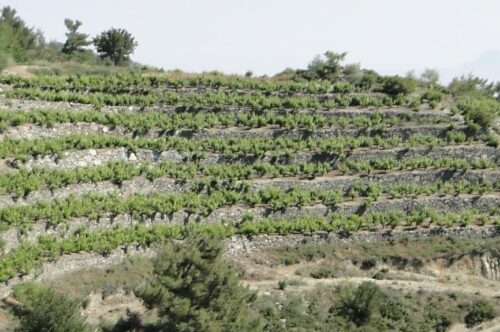Community-based restoration of mountain terraces
In the Troodos mountains in Cyprus, agriculture is often made possible by the presence of terraces. Yet, their condition is deteriorating due to land abandonment and the rise of temperatures in the region. Mountain communities have been empowered and involved in an initiative to restore the dry-stone terraces of the Ophiolite Complex of Troodos.
Erosion of mountain agricultural terraces
In the Troodos mountains, rural communities created agriculture terraces over the decades to cultivate the surrounding land. Wine grapes, almonds and cereals like barley are the main terrace-grown crops. The Ophiolite Complex of Troodos covers 2,332 km2 (40% within the Republic of Cyprus), hosts about 50,000 people and is composed of dry-stone terraces.
Over the past three decades, mountain communities’ population has more than halved while the population in foothills and downstream areas has remained relatively constant. Hence, many of the mountain terraces are no longer cultivated and damages are caused by land abandonment – 20% of the land has been abandoned since 2000.Terraces’ walls are not managed and can cause domino effects if they collapse. In addition to soil erosion, the area faced afforestation on dry lands, leading to increasing risks of forest fires. Such fires weaken soils, making them even more vulnerable to erosion, leading to a vicious circle of general degradation of agricultural land.
Involvement of mountain communities
As part of the EU-funded Horizon 2020 RE-CARE project (2013-2018), mountain communities of Polystypos, Alona and Platanistasa were engaged in the restoration of these dry-stone terraces. The project has opted for mixed governance and citizen participation to define and implement a restoration strategy. In total, 160 people were involved in the reflection and decision-making process, including: agriculture and forestry departments, Cyprus Agricultural Payment Organisation, local mountain communities (through community councils), landowners, local schools, and youth organisations.
Through workshops gathering relevant stakeholders and experts, mountain communities identified 15 solutions for the restoration of agricultural terraces. These solutions include “soft” measures, such as awareness raising activities, and more structural ones involving road construction or solving infrastructures issues.
A total of 6 terrace maintenance events were also organised between 2015 and 2017 in the Pitsilia region of the Troodos Mountains. These events gathered mountain communities, land experts, local authorities and helped to empower local people in the management of mountain terraces. The main groups targeted by these capacity-building actions were mountain farmers, landowners, and citizens.
Results of restoration activities
Within the project, an experiment was also carried out in a terraced vineyard in Alona (1300 meters above sea level) to monitor erosion from degrading and maintained terraces. Based on two-year measurements (December 2015 – November 2017), erosion from restored terraces was 3.8 times less than on collapsing terrace sections.
Terrace construction and maintenance is labour and cost intensive but is therefore effective in the long-term to prevent soil erosion. Moreover, it is essential for the preservation of mountain agriculture in the region and helps to improve yields, with farmers saying crop yields can be up to 20% higher in well-managed terraces.
As reaffirmed by local communities during the restoration process, agricultural terraces are part of the regional mountain landscape; maintaining them can thus also help to sustain mountain livelihoods, cultural heritage, and attractiveness.

